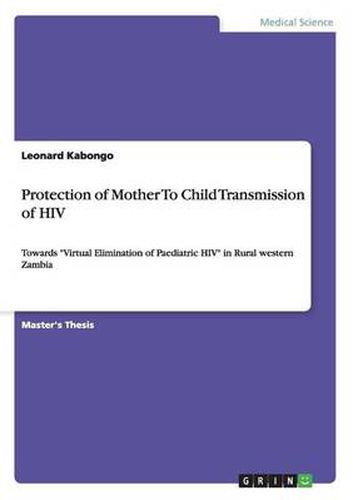Readings Newsletter
Become a Readings Member to make your shopping experience even easier.
Sign in or sign up for free!
You’re not far away from qualifying for FREE standard shipping within Australia
You’ve qualified for FREE standard shipping within Australia
The cart is loading…






Master’s Thesis from the year 2011 in the subject Medicine - Public Health, grade: B, Atlantic International University (Social and Human studies), course: Master of Public Health, language: English, abstract: Limited information exists currently on factors associated with “virtual elimination of paediatric HIV” in resource constrained settings since the publication of new PMTCT guidelines by the WHO in 2010. In this study, we aimed to assess predictors of unfavourable infant clinical outcomes (Mortality and HIV infection) at 2 years follow-up in PMTCT program. Using data collected from registers (PMTCT and ANC) at Sichili Mission Hospital, 151 women were enrolled in the program from 2008 to 2010 and 80 of them fulfilled the inclusion criteria. An in-depth interview with HIV positive women was conducted using structured questionnaires. Factors associated with “virtual elimination of paediatric HIV” were determined by multivariable regression analysis models. At 2 years follow-up, 8 (10%) children died 47(87%) were HIV negative and 7(13%) were HIV positive on HAART. Socio-demographic factors age and education level were correlated with poor infant outcomes in PMTCT program (Pearson coefficient correlation1). Socio-demographic factors, PMTCT specific indicators and infant’s variables are potential determinants to successful attainment of “Virtual elimination of paediatric HIV by 2015”. KEY WORDS: PMTCT, Virtual Elimination of Paediatric HIV, Sichili Mission Hospital, Socio-demographic variables, infant outcomes, Zambia.
$9.00 standard shipping within Australia
FREE standard shipping within Australia for orders over $100.00
Express & International shipping calculated at checkout
Master’s Thesis from the year 2011 in the subject Medicine - Public Health, grade: B, Atlantic International University (Social and Human studies), course: Master of Public Health, language: English, abstract: Limited information exists currently on factors associated with “virtual elimination of paediatric HIV” in resource constrained settings since the publication of new PMTCT guidelines by the WHO in 2010. In this study, we aimed to assess predictors of unfavourable infant clinical outcomes (Mortality and HIV infection) at 2 years follow-up in PMTCT program. Using data collected from registers (PMTCT and ANC) at Sichili Mission Hospital, 151 women were enrolled in the program from 2008 to 2010 and 80 of them fulfilled the inclusion criteria. An in-depth interview with HIV positive women was conducted using structured questionnaires. Factors associated with “virtual elimination of paediatric HIV” were determined by multivariable regression analysis models. At 2 years follow-up, 8 (10%) children died 47(87%) were HIV negative and 7(13%) were HIV positive on HAART. Socio-demographic factors age and education level were correlated with poor infant outcomes in PMTCT program (Pearson coefficient correlation1). Socio-demographic factors, PMTCT specific indicators and infant’s variables are potential determinants to successful attainment of “Virtual elimination of paediatric HIV by 2015”. KEY WORDS: PMTCT, Virtual Elimination of Paediatric HIV, Sichili Mission Hospital, Socio-demographic variables, infant outcomes, Zambia.